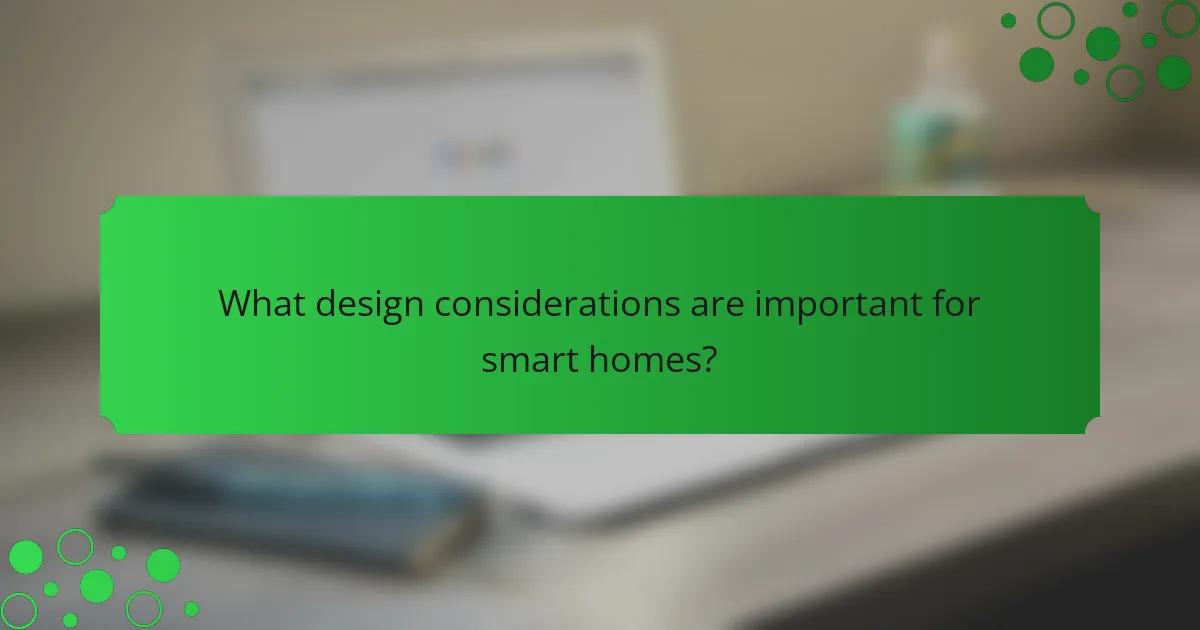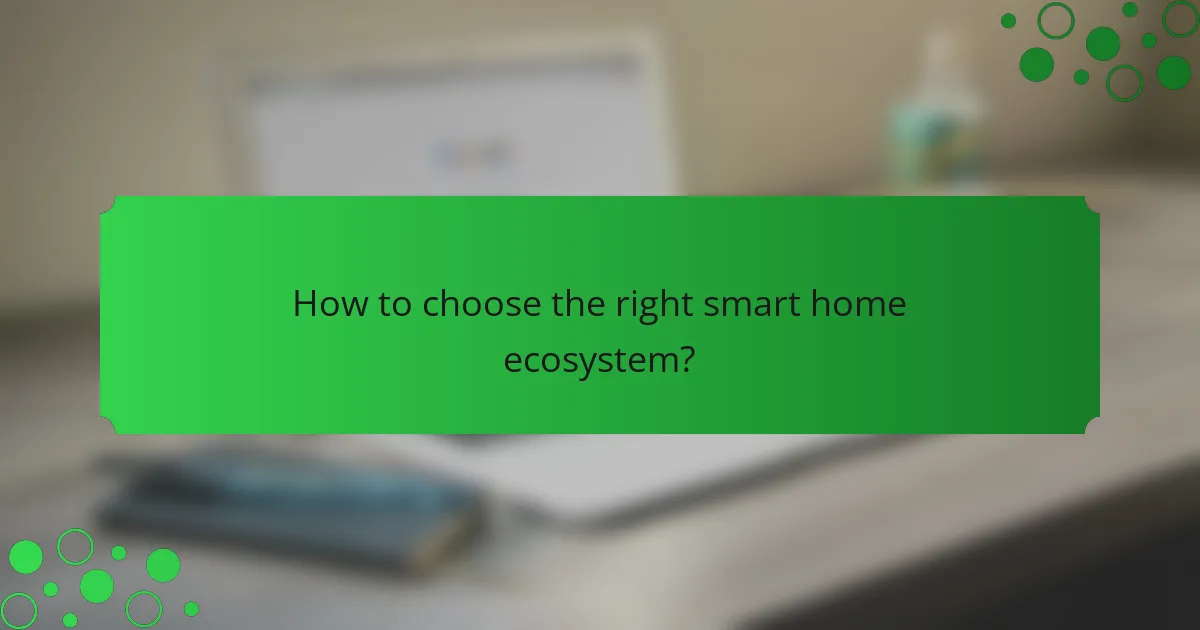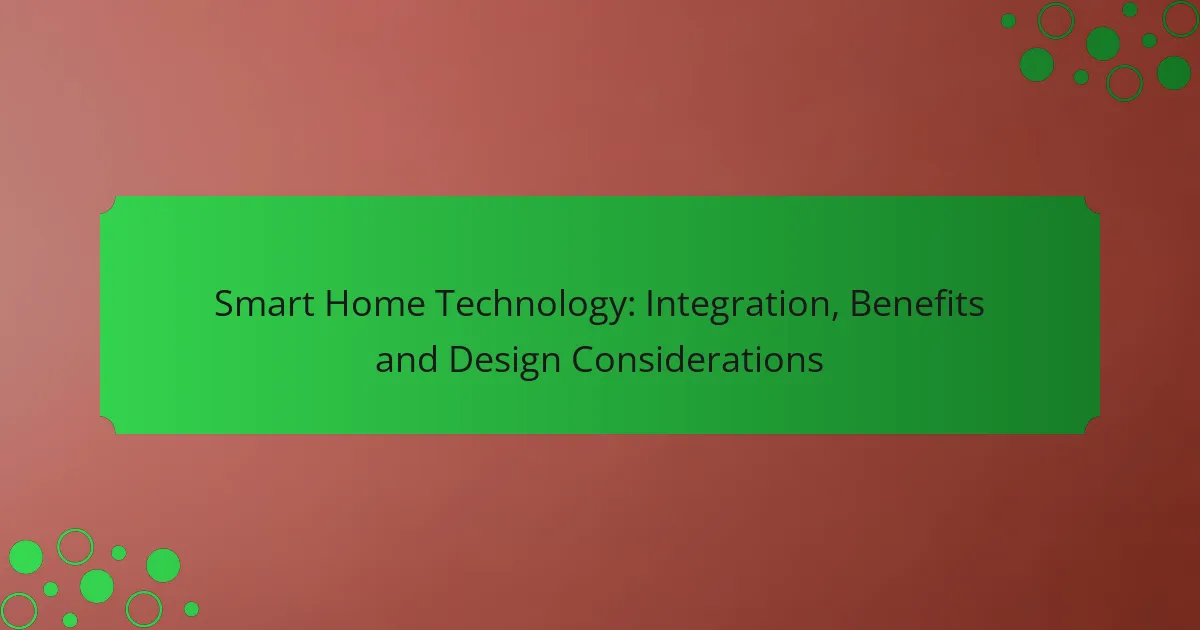Smart home technology is revolutionizing the way we live by providing enhanced energy efficiency, improved security, and unparalleled convenience. By integrating various devices to work together seamlessly, homeowners can enjoy significant cost savings and a more comfortable living environment. However, careful consideration of device compatibility, network security, and aesthetic integration is essential for creating a secure and visually appealing smart home experience.

What are the benefits of smart home technology?
Smart home technology offers numerous benefits, including enhanced energy efficiency, improved security, and increased convenience. These advantages can lead to cost savings, peace of mind, and a more comfortable living environment.
Increased energy efficiency
Smart home devices can significantly reduce energy consumption by optimizing usage patterns. For instance, smart thermostats learn your schedule and adjust heating or cooling accordingly, potentially lowering energy bills by 10-20%.
Additionally, smart lighting systems allow you to control lights remotely or set schedules, ensuring that lights are only on when needed. This can lead to further savings and a reduced carbon footprint.
Enhanced security features
Smart home technology enhances security through devices like smart locks, cameras, and motion sensors. These systems can alert homeowners to unusual activity and allow remote monitoring via smartphones.
Features such as video doorbells enable you to see and communicate with visitors without opening the door, adding an extra layer of safety. Many systems can integrate with local law enforcement for quicker response times.
Improved convenience and automation
Automation is a key benefit of smart home technology, allowing devices to work together seamlessly. For example, you can set your smart coffee maker to start brewing when your alarm goes off, ensuring a fresh cup is ready when you wake up.
Voice-activated assistants can control various devices, making it easy to adjust settings without manual input. This convenience can enhance daily routines and save time.
Remote monitoring capabilities
Remote monitoring is a significant advantage of smart home systems, enabling homeowners to keep an eye on their property from anywhere. Smart cameras and sensors provide real-time updates, allowing you to check on your home while at work or traveling.
Many systems offer mobile apps that send alerts for unusual activity, giving you peace of mind and the ability to respond quickly if needed.
Customization and personalization
Smart home technology allows for extensive customization, enabling users to tailor their systems to fit specific needs and preferences. You can create personalized settings for lighting, temperature, and security based on your lifestyle.
For instance, you can program your smart home to adjust the thermostat and lights when you arrive home, creating a welcoming environment. This level of personalization enhances comfort and satisfaction with your living space.

How to integrate smart home devices?
Integrating smart home devices involves connecting various technologies to work together seamlessly. This can enhance convenience, security, and energy efficiency within your home.
Using a central hub like Samsung SmartThings
A central hub, such as Samsung SmartThings, acts as the brain of your smart home, allowing different devices to communicate. It supports a wide range of protocols, making it easier to manage devices from various manufacturers.
When choosing a hub, consider compatibility with your existing devices and the ease of use of its app. SmartThings, for example, provides an intuitive interface for monitoring and controlling your devices from one location.
Connecting devices via Wi-Fi and Bluetooth
Wi-Fi and Bluetooth are common methods for connecting smart home devices. Wi-Fi offers a broader range and higher bandwidth, suitable for devices that require constant internet access, like security cameras.
Bluetooth, on the other hand, is ideal for devices that need to connect over shorter distances, such as smart locks or speakers. Be mindful of potential interference and ensure your router can handle multiple connections simultaneously.
Utilizing voice assistants like Amazon Alexa
Voice assistants like Amazon Alexa can simplify control of your smart home devices through voice commands. This hands-free approach allows you to manage lighting, temperature, and security systems effortlessly.
To integrate Alexa, ensure your devices are compatible and linked through the Alexa app. Regularly update your device firmware for optimal performance and security.
Implementing IFTTT for automation
IFTTT (If This Then That) enables automation by creating conditional statements between different smart devices. For example, you can set a rule to turn on your lights when your smart doorbell detects motion.
To get started, sign up for an IFTTT account and explore the available applets that suit your needs. This can significantly enhance the functionality of your devices and streamline your daily routines.

What design considerations are important for smart homes?
Key design considerations for smart homes include device compatibility, network security, scalability for future upgrades, and aesthetic integration with existing decor. Addressing these factors ensures a seamless, secure, and visually appealing smart home experience.
Device compatibility and interoperability
When selecting smart home devices, ensure they are compatible with each other and can communicate effectively. Look for products that support common standards like Zigbee, Z-Wave, or Wi-Fi, as these enhance interoperability across different brands.
Consider creating a centralized hub to manage devices from various manufacturers. This can simplify control and improve functionality, allowing for automation scenarios that involve multiple devices working together.
Network security measures
Implementing robust network security measures is crucial for protecting smart home devices from unauthorized access. Use strong, unique passwords for each device and enable two-factor authentication where available.
Regularly update device firmware and software to patch vulnerabilities. Additionally, consider setting up a separate guest network for smart devices to minimize risks to your main home network.
Scalability for future upgrades
Design your smart home with scalability in mind, allowing for easy addition of new devices or systems. Choose a flexible platform that can accommodate future technologies without requiring a complete overhaul of your existing setup.
Plan for potential upgrades by ensuring your network infrastructure can handle increased bandwidth and device connections. This foresight can save time and money in the long run.
Aesthetic integration with home decor
Smart home devices should blend seamlessly with your home’s interior design. Opt for products that offer customizable appearances or come in a variety of colors and finishes to match your decor.
Consider the placement of devices to maintain a clean look. For example, hide cables and use wall-mounted solutions where possible to keep surfaces uncluttered, enhancing the overall aesthetic of your living space.

What are the best smart home devices available?
The best smart home devices combine convenience, energy efficiency, and security. Popular options include smart lighting, thermostats, doorbells, and locks, each offering unique features that enhance home automation.
Philips Hue smart lighting
Philips Hue smart lighting allows users to control their home lighting remotely through a smartphone app or voice commands. These LED bulbs can change colors, dim, and even sync with music or movies for an immersive experience.
When considering Philips Hue, think about the necessary hub for connectivity and the compatibility with existing fixtures. The system is compatible with major voice assistants, making it easy to integrate into a smart home setup.
For optimal use, start with a few key rooms, such as the living room or kitchen, and expand as needed. Look for starter kits that include bulbs and a hub for a cost-effective entry point.
Nest Learning Thermostat
The Nest Learning Thermostat is designed to optimize home heating and cooling by learning user preferences over time. It can automatically adjust temperatures based on your schedule, helping to save energy and reduce utility bills.
Installation is straightforward, often requiring just a few tools and minimal technical knowledge. The device connects to Wi-Fi, allowing remote control via a smartphone app, and it provides energy usage reports to help users monitor their consumption.
Consider setting up temperature schedules for different times of the day to maximize savings. Be aware that some HVAC systems may require compatibility checks before installation.
Ring Video Doorbell
The Ring Video Doorbell enhances home security by allowing users to see and communicate with visitors remotely through a smartphone app. It features motion detection, night vision, and two-way audio, providing peace of mind when away from home.
Installation typically involves mounting the device near your front door and connecting it to Wi-Fi. The doorbell can send alerts to your phone when someone approaches, enabling you to monitor activity in real-time.
For best results, ensure a strong Wi-Fi signal at the installation location. Consider subscribing to Ring’s cloud storage plan for video recording access and additional features.
August Smart Lock
The August Smart Lock allows users to control their door locks remotely, providing keyless entry through a smartphone app. It can be installed over existing deadbolts, making it a convenient option for renters and homeowners alike.
This smart lock offers features such as auto-locking and the ability to grant temporary access to guests. It integrates with various smart home systems, enhancing overall security and convenience.
To maximize security, regularly update the app and monitor access logs. Consider using the lock in conjunction with other smart home devices, such as cameras or alarms, for a comprehensive security solution.

How to choose the right smart home ecosystem?
Choosing the right smart home ecosystem involves evaluating compatibility, ease of use, and the range of devices available. Consider your existing devices and how well they integrate with potential ecosystems to ensure a seamless experience.
Compatibility with existing devices
When selecting a smart home ecosystem, check the compatibility with your current devices. Many ecosystems, like Google Home or Amazon Alexa, support a wide range of third-party products, while others may be more limited. Ensure that the devices you want to use can connect easily to your chosen system.
For example, if you already own smart bulbs from a specific brand, verify that they work with the ecosystem you are considering. This can save you time and money by avoiding the need to replace functional devices.
User interface and ease of use
The user interface of a smart home ecosystem is crucial for daily interactions. Look for systems that offer intuitive apps or voice controls, making it easy to manage devices. A complicated setup can lead to frustration and decreased usage.
Consider testing the app or voice assistant in-store if possible. This hands-on experience can help you gauge whether the interface meets your preferences and needs.
Range of available devices
A diverse range of compatible devices is essential for a comprehensive smart home experience. Evaluate the types of devices offered by the ecosystem, such as security cameras, smart locks, and thermostats. A broader selection allows for more customization and functionality.
Research popular brands and their offerings within the ecosystem. For instance, Amazon Alexa has a vast array of compatible products, while Apple HomeKit may have fewer options but focuses on high-quality, secure devices.
Security and privacy considerations
Security and privacy should be top priorities when choosing a smart home ecosystem. Investigate the security features offered, such as end-to-end encryption and regular software updates. A system with strong security measures can protect your personal data and devices from unauthorized access.
Additionally, review the privacy policies of the ecosystem. Understand how your data will be used and whether you have control over it. Opt for ecosystems that prioritize user privacy and transparency.
Cost and budget
Cost is a significant factor in selecting a smart home ecosystem. Assess both the initial investment and ongoing costs, such as subscription fees for premium features. Some ecosystems may offer free basic services but charge for advanced functionalities.
Set a budget before exploring options and consider the long-term costs associated with maintaining your smart home. This will help you avoid overspending and ensure that your choices align with your financial goals.
